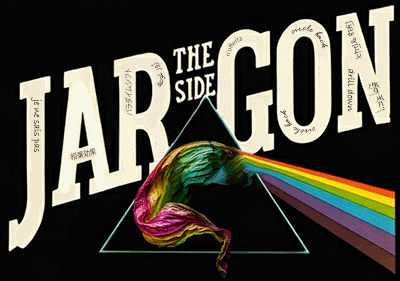Projectile Jargon
Ah, jargon! That delightful smörgåsbord of buzzwords and catchphrases, a veritable cornucopia of Babelfish-syllables in the linguistic playground where “synergy” and “paradigm shifts” dance like nobody’s watching - except Bob, who always seems to be lurking, ready to circle back and touch base about your bandwidth. Welcome to the world of thinking outside the box in hopes of moving the needle which oddly requires a SWOT instead of a thimble. But on that, I’ll bite my thumb.
Beware, dear leader, for this lexicon of the liminal is a slippery slope to boiling the frog. So buckle up, buttercup, and prepare to navigate the treacherous terrain of workplace jargon, where the only thing more terrifying than blue sky thinking is the sudden realization that you’ve not yet seen a blue sky today. Apologies, that’s no doubt orthogonal, there’s no need to deep dive into a rat hole, when we’ve hardly feasted on the low-hanging fruit.
Prefer the RTO in IRL? If serendipitous encounters and watercooler moments are your cup-of-tea, we’ll be hosting idea-generation team-building event at the local rock climbing gym this Saturday; because nothing says interlocking synergies like clinging to a rock, while your manager reminds you to leverage your core competencies to step up and elevate into actionable steps.

For everyone else: What you reading for? Still here? Made it this far?
Well, looks like we’ve got ourselves a reader!
Jargon and its not-so-modest origins
The purpose of jargon
- Efficiency (Sometimes): Jargon can be a shortcut, conveying a complex idea quickly to those familiar with it. Mostly positive?
- In-Group Signaling: Using jargon can create a sense of belonging within a group or organization (innocuous) but may have a dark side. †
- Obfuscation: Sometimes, jargon is used to deliberately obscure meaning, avoid responsibility, or create the impression that something is more impressive than the ideas being conveyed otherwise warrant.
This is where we veer into “bullshit” territory.
† Jargon as etiquette. Do you mind your manners?
The use of jargon for in-group signaling and obfuscation can be compared to the origins of etiquette. Manners, often traced to European aristocracy, involved complex social rules that distinguished the elite from lower classes. These rules, primarily conveyed through writing, created an exclusive group that marginalized those who couldn’t read, including many enslaved people who lacked access to education. This system reinforced existing social hierarchies and power structures.
Subjectivity, personal taste, & context
Is jargon subjective? On the polarity between empowerment and cringeworthy, is the human experience inherently personal? Presumably, what makes one person’s skin crawl might be another’s power phrase. Ultimately, context matters. Even the most innocuous word becomes all the more grating when overused, used incorrectly, or worse: in place of actual meaning.
Trust your gut
If your alarm bells are ringing, there’s probably a reason. Overuse of jargon, especially when it replaces clear, direct language, can be a sign of poor communication or fuzzy thinking. If in doubt, remember: clear, concise communication doesn’t require boiling the ocean, whereas the “actionable insights from synergistic touchpoints that cascade from blue sky thinking” very well may…
- You don’t need to lean in to… convey your opinions.
- You don’t need to ideate solutions to… share your ideas.
- Conversation does not require facilitating dialogue.
- Teaching does not necessitate transferring knowledge.
Complex ideas can be explained simply.
The goal is to illuminate, not intimidate. Clear language isn’t just about being understood—it’s about respecting your audience’s time and intelligence.
The dark side of jargon

From efficient, to innocuous, to grating - let’s follow the slippery slope down the proverbial Slip ‘N Slide® to its culmination: a very real, undoubtedly pernicious, negative feedback loop. Here’s how this negative feedback loop plays out:
Insecurity and the Desire to Impress
Individuals who feel insecure or unsure of themselves may gravitate towards jargon as a way to project confidence or competence. Using buzzwords can create an illusion of knowledge or sophistication, like wearing a power suit to hide a lack of experience.
Obfuscation as a Shield
When someone doesn’t actually know what to do or how to solve a problem, jargon becomes a convenient smokescreen. It allows them to appear engaged and involved without actually committing to a course of action. For instance, instead of admitting they don’t have a solution, someone might say they’re “circling back” or “doing a deep dive” to avoid taking responsibility.
In-Group Signaling and Validation
Using jargon becomes a way to signal belonging within a group. Those who use the “in” language are perceived as being “in the know,” further reinforcing the behavior. Imagine a meeting where everyone is throwing around terms like “synergy” and “bandwidth.” Those who don’t understand may feel excluded and pressured to adopt the same language to fit in.
The Loop Takes Hold
This creates a dangerous cycle where those who are most unsure and those who are bluffing the most become the most likely to overuse jargon. This leads to a culture where real communication and problem-solving suffer, as meaningful dialogue is replaced with empty buzzwords.
Consequences
Poor Decision-Making:
When clarity is replaced with buzzwords, it becomes difficult to identify and address real issues. A team discussing “strategic alignment” might spend hours debating terminology instead of focusing on the actual problem at hand, leading to delays and ineffective solutions.
Erosion of Trust
People eventually see through the facade, leading to a loss of trust in leadership and within teams. If a manager constantly uses jargon to avoid giving direct answers, their team will likely lose faith in their ability to lead and communicate effectively.
Stifled Innovation
A culture that values jargon over substance discourages creativity and critical thinking. If employees are rewarded for using buzzwords instead of generating original ideas, innovation will stagnate.
Superficial Connections
When communication is focused on impressing others rather than conveying meaning, it can hinder genuine connection and understanding. Team members who rely on jargon to fit in may struggle to form authentic relationships, leading to a lack of cohesion and collaboration.
The curious role of validation and insecurity
The simple scenario: validation, insecurity
-
Seeking External Affirmation
People who rely on jargon to impress or fit in are often seeking external validation. They want to be seen as knowledgeable, competent, and part of the “in-group.” -
Masking Insecurity
Jargon can be used to mask underlying insecurities or a lack of confidence. By using impressive-sounding words, individuals may hope to compensate for feelings of inadequacy. -
Performance vs. Authenticity
Overuse of jargon can be a form of “performing” rather than communicating authentically. It’s about creating a desired impression rather than genuinely connecting with others. -
Fear of Judgment
People who are insecure may fear being judged or rejected if they don’t use the “right” language. This can lead them to adopt jargon as a form of self-protection. -
Need for Belonging
The desire to fit in and be accepted is a fundamental human need. In a workplace where jargon is prevalent, using it can feel like a necessary step to gain acceptance and avoid being ostracized. -
Dependence on External Approval
Constantly seeking validation from others can create a sense of dependence and prevent individuals from developing their own internal sense of self-worth. -
Missed Opportunities for Growth
Relying on jargon to mask insecurities can prevent people from acknowledging and addressing their areas for development.
The complex case: projection, control
It seems paradoxical...
There’s often a strong correlation between those who overuse corporate jargon for validation and their tendency to judge others for seeking validation. It seems paradoxical, but it’s a common human behavior with roots in psychology. Research by Brown, Anicich, and Galinsky found that “Jargon sometimes functions like a fancy title, a conspicuously displayed trophy, or an expensive, branded watch — people use it to signal status and show off to others.” The overuse of jargon can lead to poor decision-making, erosion of trust, and stifled innovation within organizations. Brown et al. (2021) found that individuals who feel insecure about their professional status are more likely to use jargon as a means of seeking external validation and masking their insecurities. Does Your Office Have a Jargon Problem? by Zachariah C. Brown, Eric Anicich, and Adam D. Galinsky - Harvard Business Review
Here’s how this dynamic plays out:
-
Projection
People who are insecure or heavily reliant on external validation often project their own insecurities onto others. They may be hyper-aware of validation-seeking behavior in others because it reflects something they dislike or fear within themselves.
-
Distraction
By focusing on and criticizing the validation-seeking behavior of others, they deflect attention from their own insecurities and need for approval. It’s a way of saying, “Look at them, they’re so needy,” while unconsciously masking their own needs.
-
Maintaining a Sense of Superiority
Judging others can create a sense of superiority or control. By putting others down, they elevate themselves, at least in their own minds. This can be a way to compensate for feelings of inadequacy.
-
Justifying Their Own Behavior
Criticizing others for seeking validation can serve as a way to justify their own reliance on jargon or other approval-seeking behaviors. They might think, “Well, at least I’m not as bad as them.”
-
Lack of Self-Awareness
This dynamic often stems from a lack of self-awareness. Individuals may not be fully conscious of their own insecurities and the ways in which they seek validation. This lack of awareness can lead to judgmental attitudes toward others who exhibit similar behaviors.
Am I critical of others for seeking validation?
Recognizing this tendency for projection and judgment i crucial for growth. Ask yourself: Am I critical of others for seeking validation? If so, why? What might this say about my own needs and insecurities?
Solutions
The Trouble with Easy Answers
It’s tempting to think we can fix jargon with simple solutions, like telling leaders to “promote a culture of clarity” or encouraging people to “challenge jargon directly.” While these ideas sound good on paper, they often miss the mark. Why? Because they don’t account for the complex human factors at play.
Why “Just Say No” to Jargon Doesn’t Work
- Ego and Image: People who rely on jargon to boost their image might resist giving it up. It can be hard to let go of something that makes you feel important or knowledgeable.
- Entrenched Habits: Jargon can become deeply ingrained in a workplace. Changing those habits takes time and effort, and some people might cling to the familiar even if it’s not the best way to communicate.
- Power Dynamics: Challenging jargon used by those in authority can be risky. It might be perceived as disrespectful or insubordinate, making people hesitant to speak up.
Digging Deeper: What’s Really Going On?
To truly address the jargon problem, we need to understand its roots. This means:
- Identifying the origins and root causes: Where does the jargon come from? Why do people use it?
- Recognizing existing power dynamics: Who is using jargon, and how does their position influence its use?
- Navigating those dynamics effectively: How can we challenge jargon without stepping on toes or creating conflict?
- Accounting for asymmetric access to information: Jargon can create an uneven playing field, where those “in the know” have an advantage. We need to ensure everyone has equal access to information.
- Providing for humans behaving irrationally: People don’t always make logical choices. We need to be prepared for emotional reactions and resistance to change.
- Establishing new and durable incentives: How can we reward clear communication and discourage jargon use in a sustainable way?
Solutions with a Chance of Success
Addressing the human element is key to finding solutions that actually work. Here are some approaches that go beyond surface-level fixes:
- Self-awareness: Be mindful of your own motivations and potential biases. Ask yourself: Why am I using this word? What am I hoping to achieve? If your goal is to win an argument rather than communicate effectively, take a step back and reconsider your approach.
- Seek diverse input: Talk to trusted colleagues and see if they share your concerns about jargon. Actively seek out different perspectives to avoid getting trapped in an echo chamber. Openly discuss the negative impacts of jargon. Explain why your organization values clear communication. Promote a culture where people are more interested in being understood than showing off.
- Be curious: When you encounter jargon, don’t be afraid to ask questions. “I’m not sure I understand what ‘activate’ means in this context. Could you clarify the specific actions we need to take?” or “To make sure we’re all on the same page, could we rephrase this using more concrete language?”
- Lead by example: Model the kind of communication you want to see. Use clear, direct language and avoid unnecessary jargon.
- Build confidence, be vulnerable: This applies to both yourself and others. Work on developing skills and confidence that reduce the need for external validation. Create a safe space where people can express themselves without fear of judgment.
- Inject levity: Don’t be afraid to use humor to disarm and create a more relaxed atmosphere. Sometimes a little lightheartedness can go a long way in breaking down communication barriers. Consider creating a jargon glossary. Develop a shared document where people can define commonly used jargon terms. Where the jargon is useful, you minimize its inherent downsides. Where jargon is less useful or harmful, you may find it’s also more difficult to define, creating opportunities to subtly spotlight the difference.
- Gamify Clear Communication: Write jargon on the whiteboard. Feeling bold? Create a tally to count its usage. Invite others to contribute.
Practice moments: is there a simpler way to convey this information?
- Presenting to an especially diverse audience: If you’re speaking to a group with varying levels of expertise, using too much jargon could alienate some members.
- Explaining a new concept: When introducing a new idea, using jargon can create confusion and hinder understanding.
- Building relationships: Relying on jargon in social situations can make you seem distant or pretentious.
- Giving feedback: Using jargon-laden language when providing feedback can obscure your message and make it less impactful.
“We live in the era of the symbolic executive, when “being good at stuff” matters far less than the appearance of doing stuff, where “what’s useful” is dictated not by outputs or metrics that one can measure but rather the vibes passed between managers and executives that have worked their entire careers to escape the world of work..”

References: Brown, Z. C., Anicich, E., & Galinsky, A. D. (2021, March 19). Does Your Office Have a Jargon Problem? Harvard Business Review. Link to article
